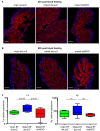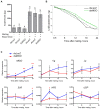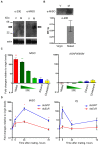The interaction between a sexually transferred steroid hormone and a female protein regulates oogenesis in the malaria mosquito Anopheles gambiae
- PMID: 24204210
- PMCID: PMC3812110
- DOI: 10.1371/journal.pbio.1001695
The interaction between a sexually transferred steroid hormone and a female protein regulates oogenesis in the malaria mosquito Anopheles gambiae
Abstract
Molecular interactions between male and female factors during mating profoundly affect the reproductive behavior and physiology of female insects. In natural populations of the malaria mosquito Anopheles gambiae, blood-fed females direct nutritional resources towards oogenesis only when inseminated. Here we show that the mating-dependent pathway of egg development in these mosquitoes is regulated by the interaction between the steroid hormone 20-hydroxy-ecdysone (20E) transferred by males during copulation and a female Mating-Induced Stimulator of Oogenesis (MISO) protein. RNAi silencing of MISO abolishes the increase in oogenesis caused by mating in blood-fed females, causes a delay in oocyte development, and impairs the function of male-transferred 20E. Co-immunoprecipitation experiments show that MISO and 20E interact in the female reproductive tract. Moreover MISO expression after mating is induced by 20E via the Ecdysone Receptor, demonstrating a close cooperation between the two factors. Male-transferred 20E therefore acts as a mating signal that females translate into an increased investment in egg development via a MISO-dependent pathway. The identification of this male-female reproductive interaction offers novel opportunities for the control of mosquito populations that transmit malaria.
Conflict of interest statement
The authors have declared that no competing interests exist.
Figures




Comment in
-
His hormone, her oogenesis: how male malaria mosquitoes trigger female egg development.PLoS Biol. 2013 Oct;11(10):e1001694. doi: 10.1371/journal.pbio.1001694. Epub 2013 Oct 29. PLoS Biol. 2013. PMID: 24204209 Free PMC article. No abstract available.
References
-
- Fowler K, Partridge L (1989) A cost of mating in female fruitflies. Nature 338: 760–761.
-
- Arnqvist G, Rowe L (1995) Sexual conflict and arms races between the sexes: a morphological adaptation for control of mating in a female insect. Proc R Soc Lond B Biol Sci 261: 123–127.
-
- Chapman T, Liddle LF, Kalb JM, Wolfner MF, Partridge L (1995) Cost of mating in Drosophila melanogaster females is mediated by male accessory gland products. Nature 373: 241–244. - PubMed
-
- Rice WR (1996) Sexually antagonistic male adaptation triggered by experimental arrest of female evolution. Nature 381: 16. - PubMed
Publication types
MeSH terms
Substances
Grants and funding
LinkOut - more resources
Full Text Sources
Other Literature Sources
Medical

